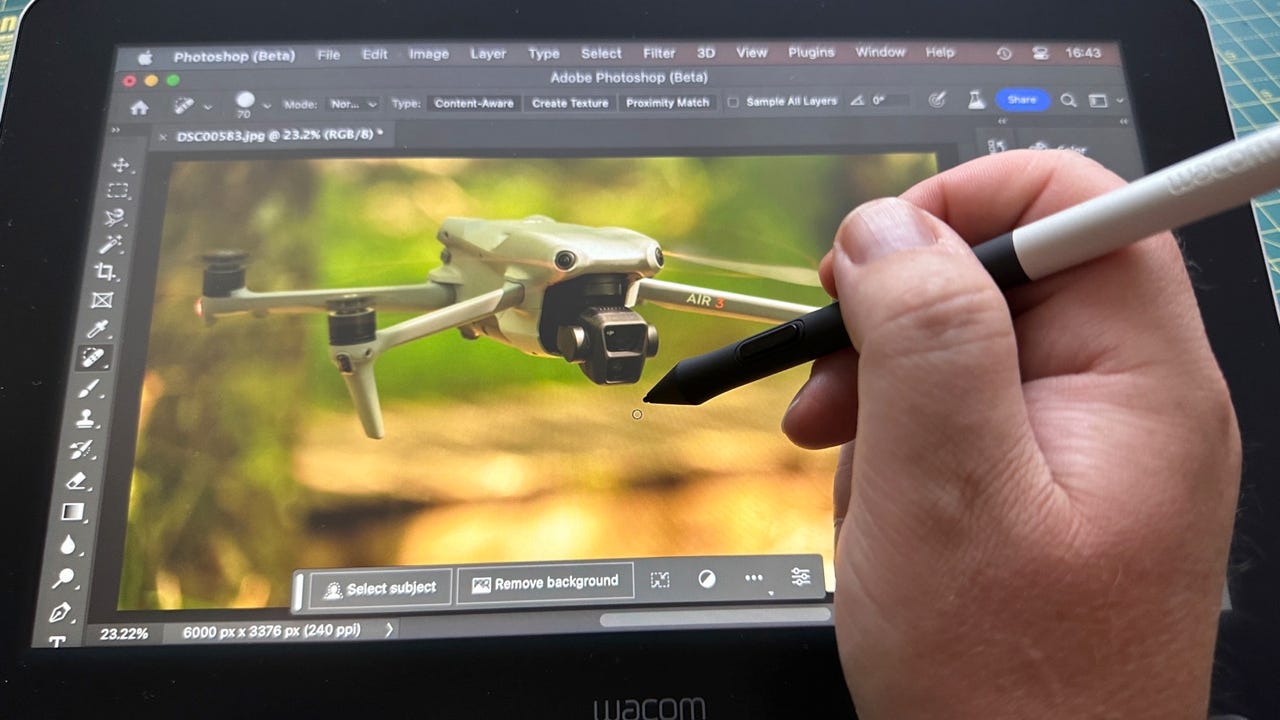This creative tablet is the best thing to happen to my photography

Wacom One tablet used to control Adobe Photoshop. Adrian Kingsley-Hughes/ZDNET
Wacom has been the go-to name for drawing tablets for as long as I can remember (over three decades), and I’ve owned a number over the years. In fact, I still regularly use a medium-sized Wacom Intuos Pro drawing tablet, and find it super handy for working in Adobe Photoshop, Lightroom, and Premiere Pro.
Once you experience the precision and intuitiveness of using a pen rather than a mouse or trackpad — which all of a sudden feels very primitive — there’s no going back.
Also: The best stylus tablets for note-taking and drawing
But what about a drawing tablet that has a screen? I’d never used one before and questioned how much I’d get out of one.
But the Wacom One changed all of that.
ZDNET RECOMMENDS
Wacom One
High-definition creative pen display designed for creative hobbyists, visual thinkers, and anyone needing a second screen or bigger digital canvas for work or play.
Wacom One tech specs
- Size: 14.1 × 8.9 × 0.6 inches
- Screen resolution: 1920 x 1080 pixels
- Active screen area: 11.6 x 6.5 inches (13.3-inch diagonal)
- Connection type: Wired
- Pen: Pro Pen 2, battery-free, tilt-recognition
- Compatibility: Windows, MacOS, Chromebook, and select Android devices
In the box, you get the drawing tablet, a pen, a USB power supply, and a cable.
That cable connects to the tablet, the USB power supply, and a USB port and HDMI port on the host computer. One thing to note here is that the connector that connects to the computer is USB-A, so if your system only has the newer USB-C ports, then you’re going to need a dongle or dock — not really much of a showstopper since most creatives have plenty of them about.
Also: Samsung Galaxy Tab S9 Ultra vs Apple iPad Pro: Which flagship should you buy?
Once the drivers are downloaded and the tablet hooked up, it just works. It’s a painless experience, as it should be, but I’ve tried a lot of off-brand tablets and have been thoroughly disappointed by the sloppiness of the drivers, how much hand-holding the tablets needed to work, and how often they’d randomly disconnect.
If you’re buying a tablet, my advice is to buy a Wacom.
OK, back to the Wacom One.
The 13.3-inch HD display is very nice.
OK, it’s not as deeply detailed as the high-resolution displays you see on Macs and other systems, but still very functional. It’s bright, the colors vivid, and it’s the perfect balance between being big enough to get work done on it. But it’s not so big as to be unwieldy.
The surface of the tablet — the bit that makes contact with the pen — also feels nice. It’s less like using an Apple Pencil on the iPad, and more like drawing on paper. There’s a nice feeling to the interface between the two.
Also: The top stylus pens (and if they work for all devices)
I’ve been using a number of creative tools on it, and find it well-suited for things like drawing or image editing. I’ve also used it for video editing, and while Adobe Premiere Pro felt cramped on it, an app like LumaFusion — which is designed for the iPad — worked much better.
Yes, I used the Wacom One to edit videos. Adrian Kingsley-Hughes/ZDNET
The pen is also nice. It’s battery-free, which means it’s lightweight and nimble, and incredibly responsive. It offers 4,096 levels of pressure, and there’s a programmable side-switch to put shortcuts right at your fingertips.
Not sure what software to try? No worries! The Wacom One comes with some trial software for you to experiment with.
- Clip Studio Paint software for drawing and painting.
- Bamboo Paper digital paper notebook from Wacom .
- Adobe Creative Cloud Photography plan .
- Adobe Fresco drawing software offers a large collection of vector and raster brushes.
The pen looks and feels like a professional bit of kit and even comes with some spare nibs in case you wear out the existing one (I don’t think I’ve ever done that) or damage it by dropping it (yeah, I’ve done that).
Also: This Wacom drawing tablet feels like putting pen to paper
Not a creative type? Then this is perfect for planning and sketching and taking notes. Anything you might do on the back of an envelope, you’ll do better using the Wacom One.
For a 13.3-inch drawing tablet that’s also a display, the Wacom One is competitively priced at $291. A jump up to the 16-inch Wacom Cintiq 16 will set you back $650, while a 24-inch Wacom Cintiq Pro 24 is $2,699.
A lot of creatives won’t get beyond what the Wacom One has to offer, and that means that it’s going to see years of use, which makes that initial investment an even better deal.
And again, you can find cheaper tablet displays, but in my experience, they’re a false economy that’ll put you off using your tablet.
For all the latest Technology News Click Here
For the latest news and updates, follow us on Google News.
